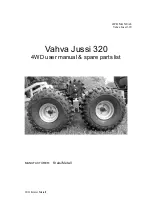
19
This document is valid only on the date printed. If unsure of the print date, re-print to ensure use of the latest version of the IFU. The onus resides with
the user to ensure that the most up-to-date IFU is used.
Infection
Wound healing disorders
Cardiovascular complications, such as blood loss, thrombosis, embolism, coagulopathy
Gastrointestinal complications, such as gastritis, ileus, ulcer
Neurological complications, such as spinal cord or neural root lesions with temporary or permanent sensory and/or motor disturbances
(bladder and rectal disorders, sexual dysfunction)
Intraoperative injury to blood vessels, massive hemorrhage, stroke, cerebral hemorrhage with potential life-threatening consequences
Injury to organs adjacent to the spine, such as cervical, thoracic and abdominal organs, depending on the region operated on
5 Warnings and precautions
5.1 General
The user has to ensure that the most current versions of the complete product materials provided as overall documentation of the system
are on hand and considered. These are also available at:
. A printed copy may be delivered within 7 days,
upon request.
This product must be used only by an experienced spine surgeon, under sterile conditions and in an operating room where C-arm is
available.
The treating physician is responsible for making the proper selection of patients, and for acquiring the training with the system and
experience required for implant selection and placement. The treating physician is also responsible for determining whether to leave the
implant following surgery or to remove it.
The product must be carefully handled and stored. Implants with any kind of damage or scratches must not be used, as product stability
and resistance to fatigue may be affected.
Implants of the corresponding ulrich medical systems must be used exclusively with the system-specific instruments intended for this
purpose, unless otherwise indicated.
Connecting ulrich medical implants to implant components of other manufacturers is not permitted. A combination with other implants
from ulrich medical is not permitted.
Given the presence of passive layers, corrosion of metal implants is very minimal. Nevertheless, there may be accelerated material fatigue
and the possibility of a break, as well as increased release of metal components in the body. Corrosion is promoted by the components
made of different metals coming into contact and by damage to the implant’s surface. Direct contact with metal implants from other
manufacturers is not allowed.
5.2 Preoperative
Implantation should only be considered when all other treatment options have been carefully weighed and ruled out as a possible better
option. A successful implant itself will also be inferior to the healthy moving element(s) of the spine. On the other hand, an implant may
be beneficial for the patient by replacing one or more severely deformed or degenerated moving elements since this eliminates pain and
a good load bearing capacity can be achieved.
The risks of the procedure and the use of the implant, including any revisions which may be necessary, should be explained to the patient
in detail.
The treating physician should conduct with the patient a detailed discussion of the surgical results that may be anticipated, particularly
with regard to potential physical limitations of the implant. The degree of postoperative activity affects the life time of the implant and
the stability of the implant in the bone. Thus, the patient must be informed of the limitations and risks inherent in daily activities and
made aware of special guidelines for movement. Smoking can inhibit fusion and may predispose to an increased rate of pseudoarthrosis.
Patients should be informed about the possible negative effects of smoking on the success of a fusion procedure. The treating physician
must assess whether the patient can understand and follow such instructions. Special attention should be given to postoperative
discussion and the need for regular medical monitoring.
Ensure that suitable pre-, intra- and postoperative diagnostic procedures are performed to evaluate and ensure proper implant selection
and placement.
Errors in implant selection could result in premature clinical implant failure. The number of segments to be treated must be accurately
determined. The shape and composition of human bones limits the size and durability of the implant.
5.3 Intraoperative
The implant is delivered sterile and must not be resterilized.
Do not use the implant if the packaging is damaged or was opened outside the sterile area.
Do not use the implant if the expiry date has passed.
Use aseptic techniques in order to avoid contamination when taking the implant out of the sterile packaging and when using the implant.
tezo-P implants are intended exclusively for use in pairs in the intervertebral space.
After the implant has been in contact with a patient, has been soiled or used, it must not be reused and must be discarded. Even if the
exterior of the implant appears unchanged, prior stress may have caused damage that can lead to implant failure.
2019-07-02
















































